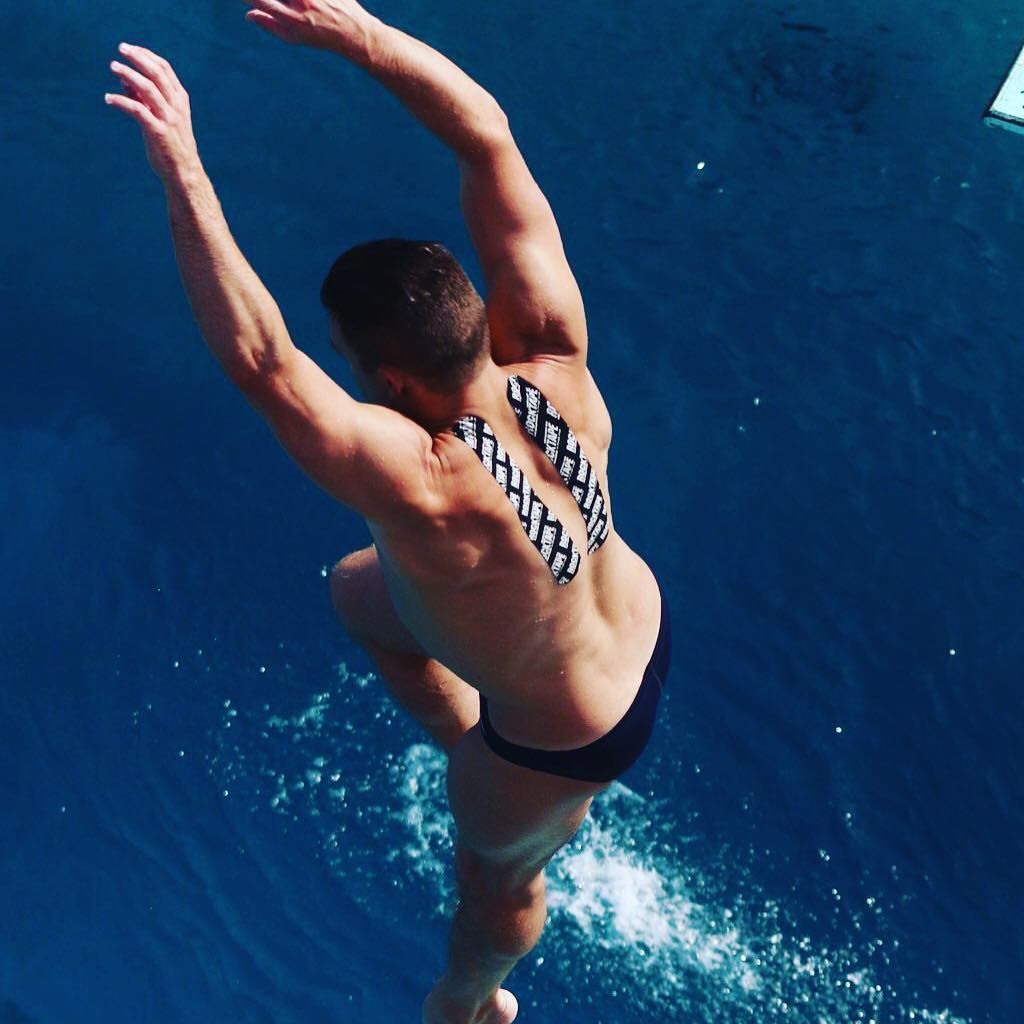Competitive divers are equal part acrobat, physicist, and daredevil. Unfortunately, this combination creates a variety of injuries – similar to common gymnastics and contact sports injuries. Boards, platforms, and pool decks are all culprits of injuries such as lacerations, contusions, abrasions, fractures, and concussions. In addition to these traumas, the precise nature of springboard mechanics and entry hydrodynamics over time can result in musculoskeletal injuries and pathologies.
For the sought-after, splashless entry expected of high caliber divers, the athlete’s body must hit the water with precision, creating the perfect angle with the surface. A few degrees difference can make a hydrodynamic marvel look like a cannonball contest. In the event of a rotational error, a diver may attempt to salvage their score by hyper-flexing or hyperextending themselves to reduce their splash on impact. By entering the water in this “c” shape instead of the preferred gentle crescent shape, a diver could expect injury to their low back. A similar error, colloquially referred to as “missing their spot” (meaning they spatially or proprioceptively get lost and consequently hit the water at the wrong angle), can result in the water violently hyperextending the athlete. In both cases RockBlades, RockSauce Ice, and manual therapy have proved valuable in addressing the resultant soft-tissue injuries. RockTape’s Low Back protocol with the vertical strip at the spinal level also relieves the discomfort of such injuries and provides increased function to divers.

Other common injuries among divers are spondylolysis and disc herniation, which are generally the result of overtraining. While physical therapy and chiropractic care are beneficial for management of these conditions, RockTape’s acute low back protocol has helped athletes with such injuries finish competing at critical competitions.
In addition to the high propensity for low back injury, the unique and difficult hand position required for entry creates heightens divers’ risk for head and neck injuries. Ideally, the athlete enters the water with one hand, palm-first and the other hand grabbing to reinforce it, in contrast to the fingertip-first position of other aquatic sports. Divers occasionally “miss” their hands (i.e. they don’t have their arms locked out or they haven’t completely grabbed their hands), which can translate to concussions or contusions, as well as neck injuries like whiplash and stingers (acute trauma to the brachial plexus). Those neck injuries, much like the low back injuries responds well to IASTM with RockBlades and RockTape’s Split Neck or Neck H protocols.
 Although spine and para-spinal injuries are some of the more serious injuries expected in the sport of diving, upper extremity issues are also common among athletes competing in the sport. The “missed hands” error discussed above can also result in acute shoulder injuries such as labral tears, rotator cuff tears, or joint subluxation/dislocations. Further, overuse and overtraining can also cause a variety of shoulder pathologies. Again, the standard complement of Blades and Shoulder Taping addresses these injuries correctly, resulting a discomfort* relief and increased functionality for the athlete. Preventatively, RockBands have proved beneficial for building shoulder stabilization and creating periscapular activation.
Although spine and para-spinal injuries are some of the more serious injuries expected in the sport of diving, upper extremity issues are also common among athletes competing in the sport. The “missed hands” error discussed above can also result in acute shoulder injuries such as labral tears, rotator cuff tears, or joint subluxation/dislocations. Further, overuse and overtraining can also cause a variety of shoulder pathologies. Again, the standard complement of Blades and Shoulder Taping addresses these injuries correctly, resulting a discomfort* relief and increased functionality for the athlete. Preventatively, RockBands have proved beneficial for building shoulder stabilization and creating periscapular activation.
Another injury, perhaps unique to diving is injury the triceps brachii, especially the long head, that is caused by its use as a shock absorber for the athlete upon entry into the water. Given its uncommon nature, such an injury requires a unique use and taping method for RockTape. Beginning in his or her overhead/entry position, the athlete flexes the elbow to further stretch the tissues. The first tape strip is anchored proximal to the elbow, covers the muscle belly and finishes just beyond the infraglenoid tubercle. A second strip is usually placed perpendicular to the first at the level of most discomfort.
Finally, the lower extremity, specifically the knee, is a common area of injury for divers. After all, divers initiate their dive with a jump. While tower divers jump barefoot from a concrete slab and springboard divers face the physics of an aluminum composite board during their hurdle, patellofemoral syndrome and patellar tendonitis/tendonosis are common in both athletes. While the RockTape knee taping has been valuable, the introduction of RockFloss to supplement such taping has also been beneficial. RockFloss is applied around the knee joint both during conventional knee range of motion exercises and with athletes modeling their hurdle for a sport specific movement. RockFloss has also aided injury prevention and recovery through its use on the lower leg to influence tibial rotation towards better alignment.
Although diving injuries encompass those endured by athletes of several different sports, RockTape provides a significant amount of relief and a competitive edge to those athletes treated through its methodologies and modalities. Despite its propensity for a wide variety of injuries, perhaps more so than in any individual contact, or no-contact sport, diving creates a unique opportunity to take advantage of the vast number of different recovery and injury tools available to the medical personnel responsible for treating its athletes.

